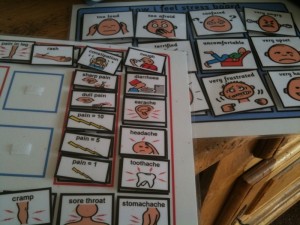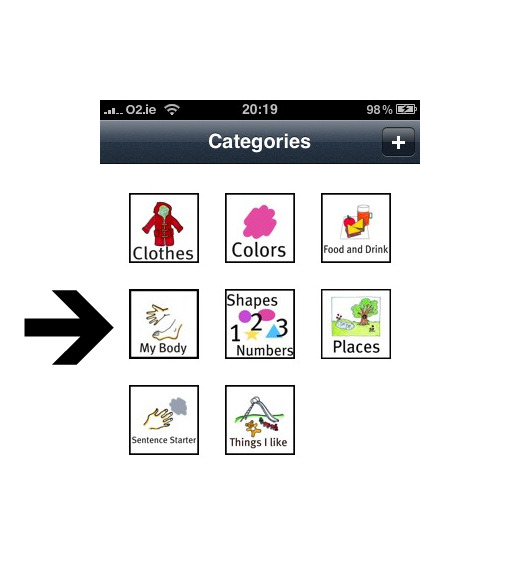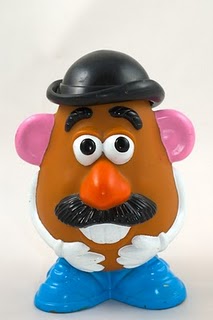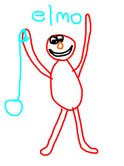The “My Body” Function
When my son Liam (who is also autistic) was small, he would play, run around and then one day turn kind of pale and listless and stop running. I would take him to the Doctor who would CRINGE as he examined Liam’s tonsils and say “They are VERY infected” then look at me like I was a BAD MOTHER.
I learned that our kids do not understand how to “Act Sick”.
Now kick aside any assumptions about “high pain thresholds”, you cannot put yourself in another person’s body and count the number of pain receptors they have. Autistic people are flesh and blood and they feel pain to the same or lesser or greater degree as anyone else.
What they don’t do naturally is learn to act like they are in pain.
So we have to teach them.
You start small, you start with something that is obviously and visibly painful; like a stubbed toe, or a bump on the knee. (for ethical reasons you cannot create trip them yourself). Stop them and sit them down while you rub the knee or toe and kiss it, apply savlon and comfort them verbally.
Give them hugs or pats while repeating “Sore Knee, OUCH!, Sore Knee”. In other words give positive 1-1 attention for the visible injury. At the same time you should be using separate opportunities to build body awareness.
Show me, Point to, What’s This? for Tummy, Forehead, Teeth, Chest, Nose, Eyes, Ears and Groin. And the idea is that they would learn to generalise – taking the extra attention they get for showing you a hurt knee, and learning to show you a sore tooth, ear, or tummy/groin.
This works great when a child can talk. Now, when my son has an ear infection he can tell us: “The ear is sore” and I can take him to the Doctor – before it gets too bad.
For my Gracie – it is much harder as she does not have the verbal language to tell us her arm, leg or ear hurts. So we rely on visuals like pictures.
 You wait for the opportunity, such as a fall and then prompt the child to say where it hurts using the picture cards. The child is actually feeling the pain as you show them – and you can tell where it does hurt as you saw it happen.
You wait for the opportunity, such as a fall and then prompt the child to say where it hurts using the picture cards. The child is actually feeling the pain as you show them – and you can tell where it does hurt as you saw it happen.
The problem of course, is that your “pain cards” are probably back home in the cupboard when they fall off the swings and graze their knee. Leaving them in the dirt crying while you go get them is not exactly ethical, or caring.
Using The “My Body” Fuction
So this is where “My Body” Function on Grace App comes in.
 When the pain happens, Grab the phone and select “My Body” Hand over Hand so the child is selecting the category picture with you.
When the pain happens, Grab the phone and select “My Body” Hand over Hand so the child is selecting the category picture with you.
 Then prompt them to choose “Sore”and “knee”. Give them a lot of care and attention around that poor sore knee and repeatedly point at the two pictures and comfort the hurt.
Then prompt them to choose “Sore”and “knee”. Give them a lot of care and attention around that poor sore knee and repeatedly point at the two pictures and comfort the hurt.
In a separate exercise; (when they are no longer in pain) you teach all the other body parts using flashcards or standard picture exchange requests. Try using our friend Mr Potato Head as a 3D teaching tool. Set up a mirror and the potato man and keep hold of the body parts. Prompt the child to request “I want nose” and “I want eyes” using Grace App.
Set up a mirror and the potato man and keep hold of the body parts. Prompt the child to request “I want nose” and “I want eyes” using Grace App.
At the same time do a little “show me your eyes” and prompt a nice point at eyes looking in the mirror together. So it is real, not abstract. They will associate the picture of “eyes” on the phone with their eyes- because they can see their eyes when you say it.
Or you could play a drawing game where you prompt them to ask for each body part by stopping and waiting for you to draw it:
 Remember to choose a character from the Reinforcer Inventory – Something they love! When prompting for a missing limb – be sure to stay quiet and point to the child’s leg, or arm, then hand over hand get them to choose “I Want —-” and then draw it. I use draw 4 free on the iPad but you could just use crayons or markers and a drawing pad. You could also print off and make 6 x 8 flashcards (ugh) and do the standard; Point to, Give me, Show me, What’s this? direct teaching.
Remember to choose a character from the Reinforcer Inventory – Something they love! When prompting for a missing limb – be sure to stay quiet and point to the child’s leg, or arm, then hand over hand get them to choose “I Want —-” and then draw it. I use draw 4 free on the iPad but you could just use crayons or markers and a drawing pad. You could also print off and make 6 x 8 flashcards (ugh) and do the standard; Point to, Give me, Show me, What’s this? direct teaching.
And from that, practice naming their real body parts with tickle or massage games, looking in a mirror together, or putting shaving cream on each part- in the bath. (Great Messy Play activity).
Keep it fun and look for lots of opportunities to repeat the game during the day. From that you will hopefully create good body awareness, and recognition that they can then generalise into understanding. And when they have a hurt you don’t know about – tell you.






